Volete aggiungere nuovi utenti e autori al vostro blog?
WordPress è dotato di un sistema di gestione degli utenti integrato. Questo consente di aggiungere utenti con diversi ruoli e livelli di autorizzazione.
In questo articolo vi mostreremo come aggiungere nuovi utenti e autori al vostro sito WordPress.
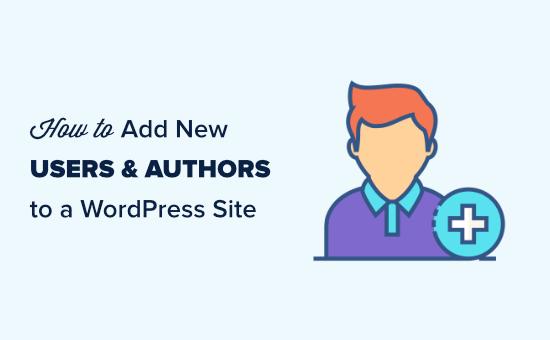
Aggiunta di un nuovo utente o autore al vostro sito WordPress
Esistono tre modi per aggiungere nuovi utenti al vostro sito WordPress. Potete aggiungere utenti manualmente, lasciare che gli utenti si registrino da soli gratuitamente o creare un sito di iscrizione a pagamento in cui gli utenti pagano per registrarsi.
Ecco cosa tratteremo in questo articolo. Fate semplicemente clic sui collegamenti rapidi per passare direttamente alla sezione di cui avete bisogno:
Video tutorial
Se preferite le istruzioni scritte, continuate a leggere.
Aggiunta manuale di un nuovo utente o autore al sito web
Se si desidera aggiungere un numero limitato di persone al proprio sito web, è facile farlo grazie al sistema di gestione utenti integrato in WordPress.
Questo metodo è ideale per:
- Piccole imprese con diversi dipendenti che gestiscono i loro siti web.
- Organizzazioni, come chiese e organizzazioni non profit, con volontari che aggiornano i loro siti web.
- Blog WordPress con più autori, come ad esempio un blog di moda che state scrivendo con alcuni amici.
- Negozi online con diverse persone che gestiscono l’inventario, la spedizione degli articoli, ecc.
È sufficiente andare alla pagina Utenti ” Aggiungi nuovo nell’area di amministrazione di WordPress.
Successivamente, è sufficiente compilare il modulo per creare un nuovo utente.
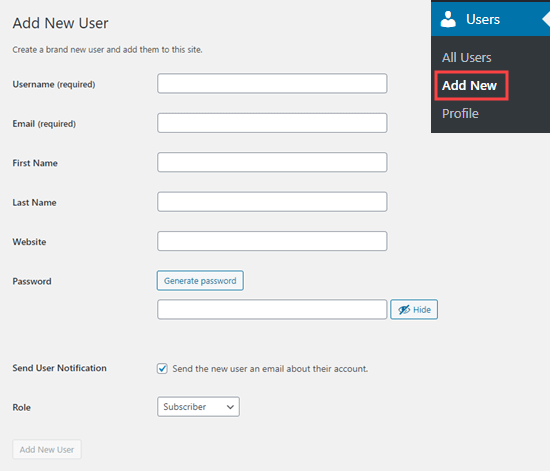
Nel modulo è necessario inserire un nome utente. L’utente può utilizzare questo o il proprio indirizzo e-mail per accedere.
Nota: il nome utente di WordPress non può essere facilmente modificato in seguito, ma tutti gli altri dettagli sì.
Quindi, inserire l’indirizzo e-mail dell’utente. Verificare che l’indirizzo e-mail utilizzato sia corretto. Gli utenti ne avranno bisogno per reimpostare la password e ricevere le notifiche via e-mail.
Successivamente, è possibile inserire il nome, il cognome e l’URL del sito web. Poiché si tratta di campi opzionali, è possibile anche lasciarli vuoti. Gli utenti possono modificare i propri profili per completare questi campi in un secondo momento.
Nella fase successiva, è necessario scegliere una password. A tale scopo, si consiglia di utilizzare un generatore di password forte online.
Si consiglia di utilizzare il pulsante “Genera password” per creare automaticamente una password forte.
Sotto il campo della password è presente una casella di controllo per l’invio di un’e-mail all’utente. Se si seleziona questa opzione, l’utente riceverà un’e-mail che gli indicherà come accedere. Questa contiene anche un link che consente all’utente di impostare una password diversa, se lo desidera.
L’ultima opzione della pagina è quella di scegliere un ruolo utente di WordPress dall’elenco a discesa.
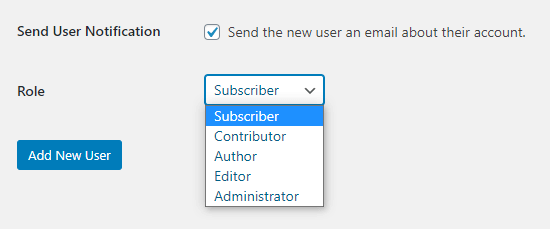
Ogni ruolo di utente è dotato di una serie di funzionalità diverse. Il ruolo di abbonato è il meno potente, mentre quello di amministratore è il più potente. È necessario scegliere un ruolo in base alle attività che l’utente dovrà svolgere sul sito web.
È possibile che si conosca già il ruolo da assegnare all’utente. In tal caso, selezionare il ruolo, quindi fare clic sul pulsante “Aggiungi nuovo utente” in fondo alla schermata.
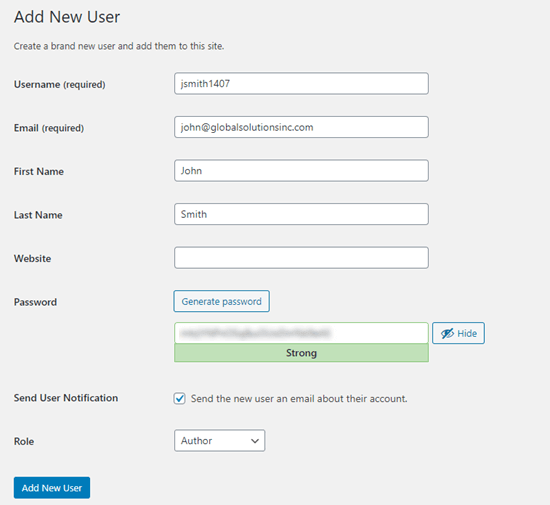
Se non siete sicuri del ruolo, non preoccupatevi. La spiegazione dettagliata dei ruoli è riportata nella prossima sezione di questo articolo.
Ricordate che alcuni plugin creano ruoli utente aggiuntivi.
Ad esempio, WooCommerce aggiunge i ruoli di “Cliente” e “Responsabile del negozio”. All in One SEO aggiunge i ruoli di ‘SEO Manager’ e ‘SEO Editor’.
È sufficiente controllare la documentazione del plugin per conoscere i ruoli aggiuntivi che si vedono in questo elenco.
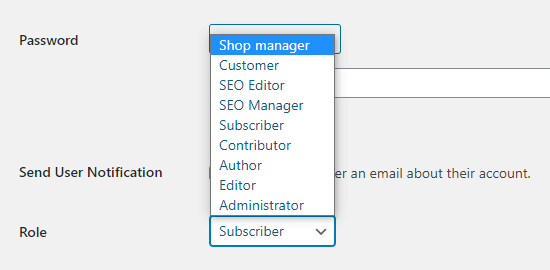
Capire i ruoli degli utenti in WordPress
WordPress viene fornito con questi ruoli utente predefiniti:
- Amministratore
- Editore
- Autore
- Collaboratore
- Abbonato
Se avete un’installazione multisito di WordPress, esiste anche un ruolo di “Super Admin”. Questi utenti possono gestire tutti i siti web, mentre i normali amministratori gestiscono un solo sito.
Amministratore
Un amministratore può eseguire tutte le operazioni sul vostro sito WordPress.
Dovreste assegnare questo ruolo solo a utenti di cui vi fidate pienamente. Dovete anche essere sicuri delle loro competenze tecniche.
Con il ruolo di amministratore, un utente può installare i plugin di WordPress, modificare i temi, cancellare i contenuti e persino eliminare altri utenti. Questo include altri amministratori.
Per saperne di più sul ruolo di amministratore, cliccate qui.
Editore
Un editor può aggiungere, modificare, pubblicare e cancellare i propri post su WordPress. Può anche eseguire tutte queste azioni per i post di tutti gli altri utenti.
Non possono accedere alle impostazioni del sito web, ai plugin, ai temi e ad altre funzioni di amministrazione.
Questo ruolo è utile se per il vostro sito avete un redattore che gestisce un team di autori e pubblica regolarmente contenuti.
Per saperne di più sul ruolo di redattore, cliccate qui.
Autore
Gli autori possono aggiungere, modificare e pubblicare i propri post. Possono anche caricare file.
Non possono modificare o pubblicare i post di altre persone o accedere a funzioni come plugin, temi, impostazioni e strumenti.
È possibile utilizzare un plugin per limitare gli autori in modo che possano scrivere solo in una categoria specifica.
Si può anche consentire agli autori di rivedere i post pubblicati. Anche in questo caso, è necessario utilizzare un plugin per estendere il ruolo dell’utente Autore.
Per saperne di più sul ruolo di autore, cliccate qui.
Collaboratore
Un collaboratore può aggiungere e modificare i propri post, ma non può pubblicarli.
Inoltre, non possono modificare i post di altri utenti o accedere a funzioni come plugin, temi, impostazioni e strumenti.
È importante notare che i collaboratori non possono caricare file multimediali, come le immagini. Il modo più semplice per ovviare a questo problema è far sì che i collaboratori carichino le immagini dei loro post attraverso un modulo di caricamento file.
In questo modo, le immagini possono essere salvate direttamente nella libreria multimediale di WordPress. In questo modo è facile per un editore o un amministratore aggiungerle al post.
Per saperne di più sul ruolo di Collaboratore, cliccate qui.
Abbonato
Il ruolo di abbonato non consente agli utenti di aggiungere o modificare i messaggi in alcun modo.
Con le impostazioni predefinite, gli iscritti possono creare un profilo e salvare i propri dati. Ciò consente di inserirli più rapidamente quando si lasciano commenti.
È anche possibile utilizzare un plugin per l’iscrizione o un plugin LMS per creare contenuti riservati ai membri e disponibili per gli abbonati. Ne parleremo più avanti in questo articolo.
Per saperne di più sul ruolo di Sottoscrittore, cliccate qui.
Per saperne di più su tutti i diversi ruoli utente di WordPress e su come si relazionano tra loro, potete consultare la nostra guida per principianti ai ruoli utente e ai permessi di WordPress.
Gestione degli utenti in WordPress
Come amministratore, potete aggiungere e rimuovere utenti dal vostro sito WordPress in qualsiasi momento. Dopo aver aggiunto un utente, potete modificare il suo profilo e cambiare tutte le informazioni, comprese le password.
È sufficiente fare clic sulla scheda Utenti nell’amministrazione di WordPress per accedere alla pagina dell’utente. È possibile modificare o eliminare un utente in qualsiasi momento.
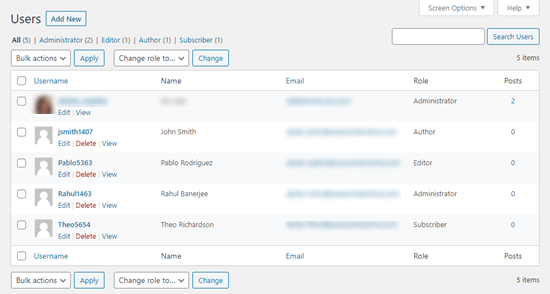
È possibile modificare il profilo dell’utente per cambiarne la password, il ruolo e altro ancora. È anche possibile modificare in blocco gli utenti per cambiare i loro ruoli, se si desidera aggiornare o ridurre i ruoli di diversi utenti allo stesso tempo.
Gli utenti possono anche modificare il proprio profilo andando su Utenti ” Profilo nella dashboard di WordPress. Possono aggiungere un’immagine del profilo e modificare la maggior parte dei loro dati, ma non possono cambiare il loro ruolo.
Aprite il vostro sito WordPress per consentire a chiunque di registrarsi gratuitamente
E se voleste permettere agli utenti di registrarsi gratuitamente sul vostro sito?
Sarebbe molto faticoso aggiungere ogni utente manualmente. Invece, si può lasciare che creino il proprio account.
Per prima cosa, è necessario andare su Impostazioni ” Generali nell’amministrazione di WordPress e selezionare la casella “Chiunque può registrarsi”.

Per impostazione predefinita, ai nuovi utenti viene assegnato il ruolo di Abbonato. È possibile cambiare questo ruolo con quello desiderato utilizzando il menu a tendina.
Attenzione: Si consiglia di consentire agli utenti di registrarsi solo come “Abbonati” o “Collaboratori”. Se si lascia che gli utenti si registrino come “Autori”, potrebbero pubblicare un post senza approvazione. Non utilizzare mai “Amministratore” come impostazione predefinita.
Non dimenticate di fare clic sul pulsante “Salva modifiche” in fondo alla pagina per memorizzare le modifiche.
È inoltre necessario aggiungere un modulo di accesso al sito. Il modo migliore per farlo è il plugin WPForms. Seguite la nostra guida su come consentire la registrazione degli utenti sul vostro sito WordPress.
Suggerimento: è possibile anche disabilitare la barra di amministrazione di WordPress per gli abbonati o per altri ruoli utente.
Creazione di un programma di iscrizione a pagamento sul vostro sito web
Un altro modo per aggiungere nuovi utenti al vostro sito è quello di creare un programma di iscrizione a pagamento a cui gli utenti si iscrivono.
Questo vi permette di vendere contenuti riservati ai soci, aggiungere contenuti premium dietro un paywall, vendere corsi online e altro ancora.
A tal fine, è necessario un plugin per i soci di WordPress.
Vi consigliamo di utilizzare MemberPress. È il miglior plugin per la creazione di membership e corsi, con tutte le funzionalità e la flessibilità necessarie.
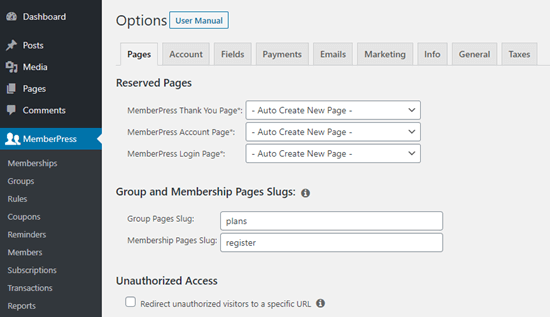
MemberPress consente di bloccare determinati post e pagine del sito in modo che solo gli utenti registrati e paganti possano accedervi. Molti siti offrono contenuti premium come questo per guadagnare online.
Con MemberPress è facile creare diversi livelli di accesso.
Ad esempio, potreste offrire un piano Bronze, Silver e Gold. Ciascuno di questi piani avrebbe un proprio ruolo utente. Potreste creare corsi separati a cui possono iscriversi solo gli utenti con determinati ruoli.
Avrete inoltre accesso a strumenti potenti come i report di MemberPress per vedere il valore medio di vita dei membri, il numero totale di membri e altro ancora.
MemberPress vi permette di aggiungere contenuti a goccia per creare un sito associativo sempreverde, e potete anche vendere iscrizioni a gruppi in WordPress.
Per un tutorial passo-passo sull’impostazione di MemberPress sul vostro sito, consultate la nostra guida definitiva alla creazione di un sito associativo in WordPress.
Speriamo che questo articolo vi abbia aiutato a capire come aggiungere nuovi utenti e autori al vostro sito web WordPress. Potreste anche consultare il nostro confronto tra i migliori servizi di email marketing e la nostra guida su come aggiungere notifiche push in modo da potervi connettere con i vostri utenti anche dopo che hanno lasciato il vostro sito web.
Se questo articolo vi è piaciuto, iscrivetevi al nostro canale YouTube per le esercitazioni video su WordPress. Potete trovarci anche su Twitter e Facebook.





Syed Balkhi says
Hey WPBeginner readers,
Did you know you can win exciting prizes by commenting on WPBeginner?
Every month, our top blog commenters will win HUGE rewards, including premium WordPress plugin licenses and cash prizes.
You can get more details about the contest from here.
Start sharing your thoughts below to stand a chance to win!
Mrteesurez says
Nice post.
Why is it that a subscriber also see the admin bar when he is not having any function to do with it ?
Concerning the username, it’s possible to change it, I have read that from on of your post. thanks.
WPBeginner Support says
It depends on the site, some add tools for users in the admin area while others don’t want users in the admin area.
Admin
Anik says
quite helpful. Thanks for posting.
WPBeginner Support says
You’re welcome, glad it was helpful
Admin
oro says
nice article , thanks for sharing
WPBeginner Support says
Glad you found our article helpful
Admin
waseem says
Is there a way to categorize self registered users and admin registered users using a plugin or manually?
WPBeginner Support says
For doing that, you could create different user roles for admin added and have the standard signup be registered as a different role.
Admin
A Mueed says
I’ve assigned an author and am using User Role editor. My author has no access to elementor builder, how can I enable that for him? I would be grateful if you could resolve this issue, Thanks.
WPBeginner Support says
You would want to check your Elementor settings to ensure that you are not preventing access in the plugin’s settings.
Admin
Sushant Singhal says
Earlier, I could go to my site’s dashboard, add user, assign role for him / her and that was it.
Now, as per new interface, I can only invite a person to become user / author / editor etc. Even when a invited person accepts invitation by confirming through his email box, he / she is not accepted as user.
When he / she logs into the wordpress.com, he is prompted to create a new website instead of taking him to the website for which he has been added as a user. Although I know that the invitation has been accepted by the invitee, he/she continues to be shown as ‘pending invitation’. Why so?
Is there some bug? Can’t I get that earlier system where I could add Authors to my website by entering their details and assigning them a user name and password?
WPBeginner Support says
You would sadly need to reach out to WordPress.com for this question, our tutorials are for WordPress.org sites: https://www.wpbeginner.com/beginners-guide/self-hosted-wordpress-org-vs-free-wordpress-com-infograph/
Admin
Jolie Royal says
It’s hard to come by well-informed people on this topic,
however, you sound like you know what you’re talking about!
Thanks
WPBeginner Support says
Glad our article could be helpful
Admin
Princess Easterling says
I like the valuable information you provide for your articles.
I will bookmark your blog and test once more right here regularly.
I am quite certain I will learn lots of new stuff right here!
Best of luck for the following!
WPBeginner Support says
Thank you, glad our content can be helpful
Admin
Steven says
Where do the users I add go to log in once I’ve added them?
WPBeginner Support says
You can see the users under Users>All Users in your wp-admin area
Admin
Merrill Whipple says
It’s actually a nice and useful piece of info. I am happy that
you shared this helpful information with us. Please keep us informed like this.
Thank you for sharing.
WPBeginner Support says
Glad you liked it and found it helpful
Admin
Sasha says
Is there a way to send a bulk email to all the Users with Author or Admin access containing their login details?
WPBeginner Support says
Not one we would recommend at the moment
Admin
Caitlin Zimmermann says
For newest information you have to visit world wide web and on world-wide-web I found this
site as a finest web site for hottest updates.
WPBeginner Support says
Thanks, glad you’ve found our content helpful
Admin
Lynn Loveless says
Somе genuinely superb articles οn this website, thank үoᥙ foг contribution.
WPBeginner Support says
Glad you like our articles
Admin
Lou Steigrad says
That is a great tip especially to those fresh
to the blogosphere. Short but very accurate information… Thank you for sharing this one.
A must read post!
WPBeginner Support says
Glad you found our post helpful
Admin
Jason Baskerville says
Having read this I believed it was really enlightening.
I appreciate you spending some time and effort to put this short article together.
I once again find myself personally spending a lot of time both reading and leaving comments.
But so what, it was still worthwhile!
WPBeginner Support says
Glad you find our articles educational and useful
Admin
Meagan Bales says
Very soon this website will be famous amid all blogging viewers, due to it’s pleasant articles
WPBeginner Support says
Glad you find our articles helpful
Admin
Mostafa says
after I added a new user
automatically WordPress send email to this user to tell his
but I want WordPress doesn’t it
How can I do that?
Jeffry Rentoul says
Whats սp this is kind of of off topic but I waѕ wondering if blogs use WYSIWYG editors oг if you hɑѵe to manually
code with HTML. I’m starting а blog soon but have no coding experience so I wаnted to get
guidance fгom someone ԝith experience. Αny help ѡould Ьe enormously appreciated!
WPBeginner Support says
Hi Jeffry,
Yes they have WYSIWYG editor to write your content. You don’t need to add HTML unless you want to.
Admin
Tesla says
but how can i edit a user dashboard without affecting the whole page and other users dashboard
Miroslav says
Respect. How to add a user who will be able to see what I (as administrator) is a complete control panel but without the ability to add, change or delete – but just review what I did. This is what I need to keep a look at the layout of the site and point to the possibility of solving the problem I have. Thank you!
WPBeginner Support says
Hi Miroslav,
Users will only be able to see the areas where they can make changes. For example, if you want them to be able to see theme settings, then they will also be able to modify them.
Admin
Okpala Precious says
Hi, I just employed someone to my blog and added him as a user. I don’t want him to have access or to be logging in to my site dashboard with the main details. How can I make him have his own log in details or which link would lead him to the dashboard as an Author?
samsta says
hello. i have been added to be a user administrator to another wordpress account, however i’m not able to see that website under my profile. i have to go on to the website and login everytime i need to contribute something. is there anyway i am able to see said website under my profile or on my dashboard to access it easily?
richie treadway says
How do I add an authors name so I can credit them for guest posts, without actually giving them access to my site?
WPBeginner Support says
Hi Richie,
Please see our guide on how to add guest author name with custom fields in WordPress.
Admin
Nicola Hasted says
Hi, is it possible to add an existing WP user to a site using their gravatar or WP login? I have been added to a clients site in this way but I don’t know how they achieved it (I received no email or new password etc).
WPBeginner Support says
Hi Nicola,
Yes, they can do that. Unfortunately, there is no way to stop this from happening. If they added you without your permission, then you can ask them nicely to stop. If they have used your Gravatar profile to publish content, then you have the option to take legal action. You can send them a cease and desist notice.
Admin
Nicola Hasted says
Thanks – it’s not a problem. In fact, I want to know how to do it for my own WP sites! And for future reference with other clients. When I go to “Add User” it wants a password set up. But I was able to access their site with my own WP login info. How is it done, please?
WPBeginner Support says
Hi Nicola,
They can add your login email but they cannot add your password. You can go to Add New User page and select the checbox next to ‘Send User Notification’ option. Make sure that you don’t click on show password button. This way users will receive an email notification to set their password and login.
Cameron Tomasini says
Hello there! Quick question that’s entirely
off topic. Do you know how to make your site mobile friendly?
My weblog looks weird when viewing from my iphone. I’m trying to find a theme or plugin that might be able to correct this problem.
If you have any recommendations, please share. With thanks!
WPBeginner Support says
Hi Cameron,
Best way to do this is by choosing a mobile friendly WordPress theme. Check out the showcase section on our website for our theme lists. All themes in those lists are mobile responsive.
Admin
Pradeep Singh says
Hello This article really helpful for me. I was searching such type of content, now I am able to add new editor, contributor or author in my wordpress website
Thanks
WPBeginner Support says
Hi Pradeep,
We are glad you found the article helpful. You may also want to subscribe to our YouTube Channel for WordPress video tutorials.
Admin
Gerald Fisher says
I am part of a blog that has been out of service for a while. The blog owner wants to start back up again. He has invited me as an adminstrator and wants me to invite new member. The only page I can get when I click on “add new” is “add existing user”. I cannot load the ‘add new user’ page that you show towards the top of this article. Can anyone tell me what we (or maybe just I) are doing wrong? Thanks
Alisa Woolery says
This page certainly has all the information and facts I needed
about this subject and didn’t know who to ask.
Harrison Hemming says
Do you mind if I quote a couple of your articles as long as I provide credit and sources back to your webpage?
My website is in the very same niche as yours and my visitors would genuinely benefit from a lot of the information you present here.
Please let me know if this okay with you. Appreciate it!
David Reay says
I relish, result in I found just what I was taking a look for.
You have ended my four day lengthy hunt! God Bless you man. Have a nice day.
Bye
Raphael Nava says
I loved as much as you’ll receive carried out right here. The sketch is tasteful,
your authored material stylish. nonetheless, you command get bought an shakiness over that you wish be delivering the following.
unwell unquestionably come more formerly again as exactly the
same nearly a lot often inside case you shield this hike.
Carroll Barff says
Whats up very cool website!! Man .. Excellent .. Superb ..
I will bookmark your site and take the feeds additionally?
I’m glad to find so many helpful info right here within the submit, we’d like work outt
extra techniques on this regard, thanks for sharing.
. . . . .
Gregg Greenwell says
This paragraph presents clear idea in support of the
new people of blogging, that truly how to do blogging.
Tim Conklin says
Hey I know this is off topic but I was wondering if you knew of any widgets I could add to
my blog that automatically tweet my newest twitter updates.
I’ve been looking for a plug-in like this for
quite some time and was hoping maybe you would have some experience
with something like this. Please let me know if you
run into anything. I truly enjoy reading your blog and I look forward
to your new updates.
WPBeginner Support says
Hey Tim,
Please take a look at our guide on how to schedule WordPress posts for social media with Buffer. It allows you to automatically share new posts from your blog to Twitter, Facebook, and LinkedIn.
Admin
Carey Mutch says
Pretty! This has been a really wonderful article.
Thanks for providing this info.
Zak Fauchery says
There is certainly a lot to find out about
this issue. I really like all the points you have made.
Ophelia Hotchin says
Hmm is nyone else experiencing problems with the images
on this blog loading? I’m trying to find out if its a problem on my end or if it’s
thhe blog. Any feedback would be greatly appreciated.
Maddison Gann says
Howdy! Quick question that’s entirely off topic. Do you know how to make your site mobile friendly?
My site looks weird when viewing from my apple iphone.
I’m trying to find a template or plugin that might be able to fix this problem.
If you have any suggestions, please share. Thanks!
Rosita Devito says
Only wanna say that this is very beneficial, Thanks for taking your time
to write this.
Bernard Hennings says
Nice weblog here! Additionally your site quite
a bit up very fast! What host are you using? Can I get your associate hyperlink in your host?
I want my site loaded up as fast as yours lol
WPBeginner Support says
Hi Bernard,
Our website is hosted on a dedicated server with HostGator.
Admin
Stephen Allison says
Nice blog here! Additionally your website a lot
up very fast! What web host are you the use of? Can I am getting your
associate hyperlink on your host? I want my site loaded up as fast as yours lol.
Bryan Corbo says
If you would like to get much from this article then you have to apply
such techniques to your won weblog.
Fausto Hair says
Hi this is kinda of off topic but I was wanting to know
if blogs use WYSIWYG editors or if you have to manually code
with HTML. I’m starting a blog soon butt have no coding expertise sso I wanted to
get guidance from someone with experience. Any help would bee greatly appreciated!
WPBeginner Support says
Hi Fausto,
WordPress comes with an easy to use WYSIWYG editor called Visual Editor. It also comes with a text editor for more advanced users who want to write plain HTML.
Admin
Christian Cremean says
Thanks for finally writing about >How to Add
New Uses and Authors to Your WordPress Bloog <Liked it!
Onyango says
After adding a user, what password does he use?
Modesta Corbin says
Hello! I know this is somewhat off topic but I was wondering which blog platform are you using for this website?
I’m getting sick and tired of WordPress because I’ve had issues with hackers and I’m looking at options for another
platform. I would be great if you could point me in the direction of a good platform.
WPBeginner Support says
Hi Modesta,
We are using WordPress for this website. We use WordPress for all our websites. As for security, you may want to see our WordPress security guide to protect your website against hackers.
Admin
Rusty Rubeo says
That is a great tip particularly to those new to the blogosphere.
Short but very precise information… Thank you for
sharing this one. A must read post!
Ulrich Dortch says
Hi there! Do you know if they make any plugins to help with SEO?
I’m trying to get my blog to rank for some targeted keywords but I’m not seeing very good success.
If you know of any please share. Cheers!
WPBeginner Support says
Hi Ulrich,
Please check out our WordPress SEO guide for beginners.
Admin
Sienna Hopwood says
I know this if off topic but I’m looking into starting
my own blog and was curious what all is required to get
set up? I’m assuming having a blog like yours would cost a pretty penny?
I’m not very internet smart so I’m not 100% sure. Any tips or
advice would be greatly appreciated. Thanks
WPBeginner Support says
Hey Sienna,
Please see our guide on how to start a WordPress blog. The cost actually depends on how fast your site grows and how much you want to invest on it.
Admin
Louann Saucier says
I think that what you published was actually very reasonable.
But, think about this, what if you composed a catchier post
title? I am not suggesting your content isn’t good, however what if you added
a headline that grabbed people’s attention? I mean How to Add
New Users and Authors to Your WordPress Blog is kinda boring.
You could peek at Yahoo’s home page and watch how they create post headlines to get
viewers to click. You might add a related video or a pic or two
to get people interested about what you’ve got to say.
Just my opinion, it could bring your posts a little livelier.